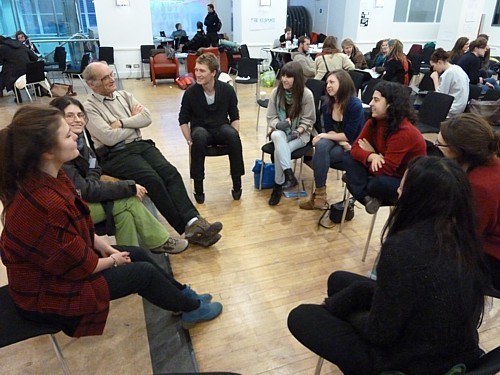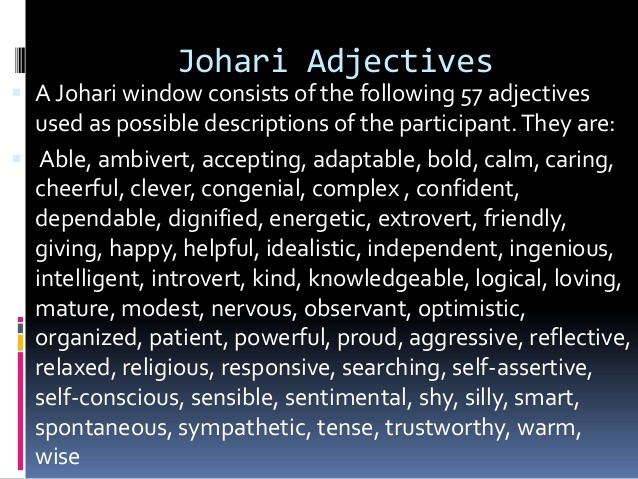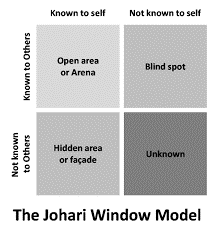Johari Window for self awareness
 Joseph Luft and Harrington Inghm – both American psychologists shaped a technique in 1955; this technique is famously called Johari Window. It helps people understand their relationship with self and others. Please understand it is very important to have a good relationship with self; when we are at peace with self we can take precise decisions in life. It is the foundation of everything in our life. Having a good relationship with self helps us to improve our relationships with others. A good self-relationship enhances our capability to value our self as a person, which helps us to embrace our strengths and weaknesses easily. Johari Window helps people first to understand them better, and then improvising their vital relations in life.
Joseph Luft and Harrington Inghm – both American psychologists shaped a technique in 1955; this technique is famously called Johari Window. It helps people understand their relationship with self and others. Please understand it is very important to have a good relationship with self; when we are at peace with self we can take precise decisions in life. It is the foundation of everything in our life. Having a good relationship with self helps us to improve our relationships with others. A good self-relationship enhances our capability to value our self as a person, which helps us to embrace our strengths and weaknesses easily. Johari Window helps people first to understand them better, and then improvising their vital relations in life.
Luft and Ingham called their technique/model Johari Window model ‘Johari’ after merging their first names, Joe and Harry. The Johari Window soon became a widely used model for understanding and training self-awareness, personal development, improving communications, interpersonal relationships, group dynamics, team development and inter-group relationships. This model is used primarily in groups especially in corporate settings as a heuristic exercise. ‘Heuristic’ means enabling a person to discover or learn something for himself/herself. In corporate culture and societies group dynamics matters for success of business or scheme; because group dynamics can be useful in understanding decision-making behavior, tracking the spread of diseases, wrong information in society, creating effective therapy techniques, and following the emergence and popularity of new ideas and technologies.
 When performing this exercise, subject (group member) is given a list of 57 adjectives and they are supposed to pick five or six that they feel illustrate their own individuality. Peers of the subject are also allowed pick five or six adjectives each that describe the subject. These adjectives are then mapped on a grid (framework). There are four Johari Window perspectives; they are called ‘regions’ or ‘areas’ or ‘quadrants’. Each of these quadrant or region contains and represents the information, knowledge, feelings, motivation, etc known about the person, in terms of whether the information is known or unknown by the person and others in the group. It is observed that the exercise helps in understanding some inherent, instinctive potential of a person which the person himself or the group was not aware of.
When performing this exercise, subject (group member) is given a list of 57 adjectives and they are supposed to pick five or six that they feel illustrate their own individuality. Peers of the subject are also allowed pick five or six adjectives each that describe the subject. These adjectives are then mapped on a grid (framework). There are four Johari Window perspectives; they are called ‘regions’ or ‘areas’ or ‘quadrants’. Each of these quadrant or region contains and represents the information, knowledge, feelings, motivation, etc known about the person, in terms of whether the information is known or unknown by the person and others in the group. It is observed that the exercise helps in understanding some inherent, instinctive potential of a person which the person himself or the group was not aware of.
Charles Handy, an Irish philosopher specialized in Organizational Behavior calls this model as Johari House with four rooms.
Room 1 is the part of ourselves that we see and others see. It is also called Open Area or Arena. Adjectives that are selected by both the participant and his or her peers are placed into the Open Area quadrant. In short, this quadrant represents information what you know about yourself and others also know about you. There are some character traits about us which are apparent, and even if we decide we can’t veil them. We work better when there is nothing to hide.
 Room 2 is the characteristics that others see in the subject which he/she is not aware of. They are called Blind Spots. This quadrant uses adjectives used by the peers. The subject is not aware some of his characteristics which other see in him. This quadrant helps in making the subject aware of some of his characteristics which he has not realized, but others have seen it in him. This quadrant helps the subject to realize some of his unsighted characteristics. We often don’t see some of our traits which are “too close” to be properly seen; our ego and our self-worth covers up our deficiencies especially those that only the people closest to us can notice. There are people who keep rebuffing about their blind spots when brought to their attention. They react harshly, and do not acknowledge and correct their faults; such people eventually end up being hit with much bigger problems. Wise people accept their blind spots and try to correct them.
Room 2 is the characteristics that others see in the subject which he/she is not aware of. They are called Blind Spots. This quadrant uses adjectives used by the peers. The subject is not aware some of his characteristics which other see in him. This quadrant helps in making the subject aware of some of his characteristics which he has not realized, but others have seen it in him. This quadrant helps the subject to realize some of his unsighted characteristics. We often don’t see some of our traits which are “too close” to be properly seen; our ego and our self-worth covers up our deficiencies especially those that only the people closest to us can notice. There are people who keep rebuffing about their blind spots when brought to their attention. They react harshly, and do not acknowledge and correct their faults; such people eventually end up being hit with much bigger problems. Wise people accept their blind spots and try to correct them.
 Room 3 is our private space; there are many things about us which we hide from others. It is called Hidden or Façade. This quadrant represents adjectives selected only by subject, but not by any of his peers. This information is private only to the subject; it is up to the subject to disclose this information or not.
Room 3 is our private space; there are many things about us which we hide from others. It is called Hidden or Façade. This quadrant represents adjectives selected only by subject, but not by any of his peers. This information is private only to the subject; it is up to the subject to disclose this information or not.
Room 4 is the most mysterious or baffling room. In this quadrant the unconscious or subconscious part of the subject rests which neither he sees nor others. It is also called Unknown. Adjectives those were not selected by either subjects or by his peers remain in this quadrant; which represent the unknown characteristics of the subjects. This quadrant informs the group regarding behaviors or motives of the subject which were not recognized by anyone participating. This may be because they do not affect anybody or it can also be because of collective ignorance of the existence of those traits.
 What is interesting about this quadrant is that the human potential of the subject which neither he nor his colleagues realize are veiled. It remains unknown. Human potential is limitless. It is sad that till end some people do not unleash their potential which is perhaps the biggest tragedy. When potential of some people remain underutilized it has reasons. Sometimes their ability is under-estimated, untested due to lack of opportunities, lack of encouragement, lack of confidence and training. Some lack the natural ability or aptitude to realize their potential that they possess. Some people have fear or an aversion to tap their natural instinct. Some people repress their subconscious feelings, and some are conditioned to wrong outlook.
What is interesting about this quadrant is that the human potential of the subject which neither he nor his colleagues realize are veiled. It remains unknown. Human potential is limitless. It is sad that till end some people do not unleash their potential which is perhaps the biggest tragedy. When potential of some people remain underutilized it has reasons. Sometimes their ability is under-estimated, untested due to lack of opportunities, lack of encouragement, lack of confidence and training. Some lack the natural ability or aptitude to realize their potential that they possess. Some people have fear or an aversion to tap their natural instinct. Some people repress their subconscious feelings, and some are conditioned to wrong outlook.
The aim in any group should always be to develop the ‘open area’ for every person, because when we work in this area with others we are at our most effective and productive self and the group becomes most productive too. The open free area, or ‘the arena’, can be seen as the space where good communications and cooperation occurs and is free from distraction, mistrust, confusion, conflict and misunderstanding.
 When Johari Window technique is used in an organization for bringing in healthy work atmosphere, it is seen that established and mature team members tend to have larger open areas because of their experience and acumen than new team members. New team members start with relatively small open areas because comparatively new team members tend to share little knowledge. The size of the open area can be expanded horizontally into the blind space, by motivating and speaking actively by listening to feedback from other group members. This process is known as ‘feedback solicitation’. This exercise becomes effective when group members decide to use the opportunity for self help and helping other team members to expand their open area. This they can do by offering response, perceptively of course. The size of the open area can also be expanded vertically downwards into the hidden or façade space by the person’s disclosure of information regarding his experience in life, circumstances and feelings etc. Group members can help a person expand his/her open area into the hidden area by allowing the person talk freely by pay attention to him. Team leader thus play an important role in facilitating feedback and confession among group members, and in directly giving feedback to individuals.
When Johari Window technique is used in an organization for bringing in healthy work atmosphere, it is seen that established and mature team members tend to have larger open areas because of their experience and acumen than new team members. New team members start with relatively small open areas because comparatively new team members tend to share little knowledge. The size of the open area can be expanded horizontally into the blind space, by motivating and speaking actively by listening to feedback from other group members. This process is known as ‘feedback solicitation’. This exercise becomes effective when group members decide to use the opportunity for self help and helping other team members to expand their open area. This they can do by offering response, perceptively of course. The size of the open area can also be expanded vertically downwards into the hidden or façade space by the person’s disclosure of information regarding his experience in life, circumstances and feelings etc. Group members can help a person expand his/her open area into the hidden area by allowing the person talk freely by pay attention to him. Team leader thus play an important role in facilitating feedback and confession among group members, and in directly giving feedback to individuals.
Don’t we all need somebody to tell us our blind spots? Johari Window will give you many “blind spot checkers.” Once these are identified, we can work out an action plan together. Organizations prosper when they promote a culture and expectation for open, honest, positive, helpful, constructive, sensitive communications, and the sharing of knowledge throughout the organization. If you look at successful organizations around or the best performing groups, departments, you will observe that they have a culture of open positive communication. So the moral of this article is to encourage individuals and organizations to work more in ‘open area’ to get best results. Open area stimulates better communication, resolves conflicts, reciprocation and gratification. And friends, healthy relationship with your colleagues can be one of the best supports in life. Good relationships strengthen our wellbeing and when relationships do not work, it drains us tremendously.












































